Immigration and Customs Enforcement has kept its use of deadly force secret. Until now.
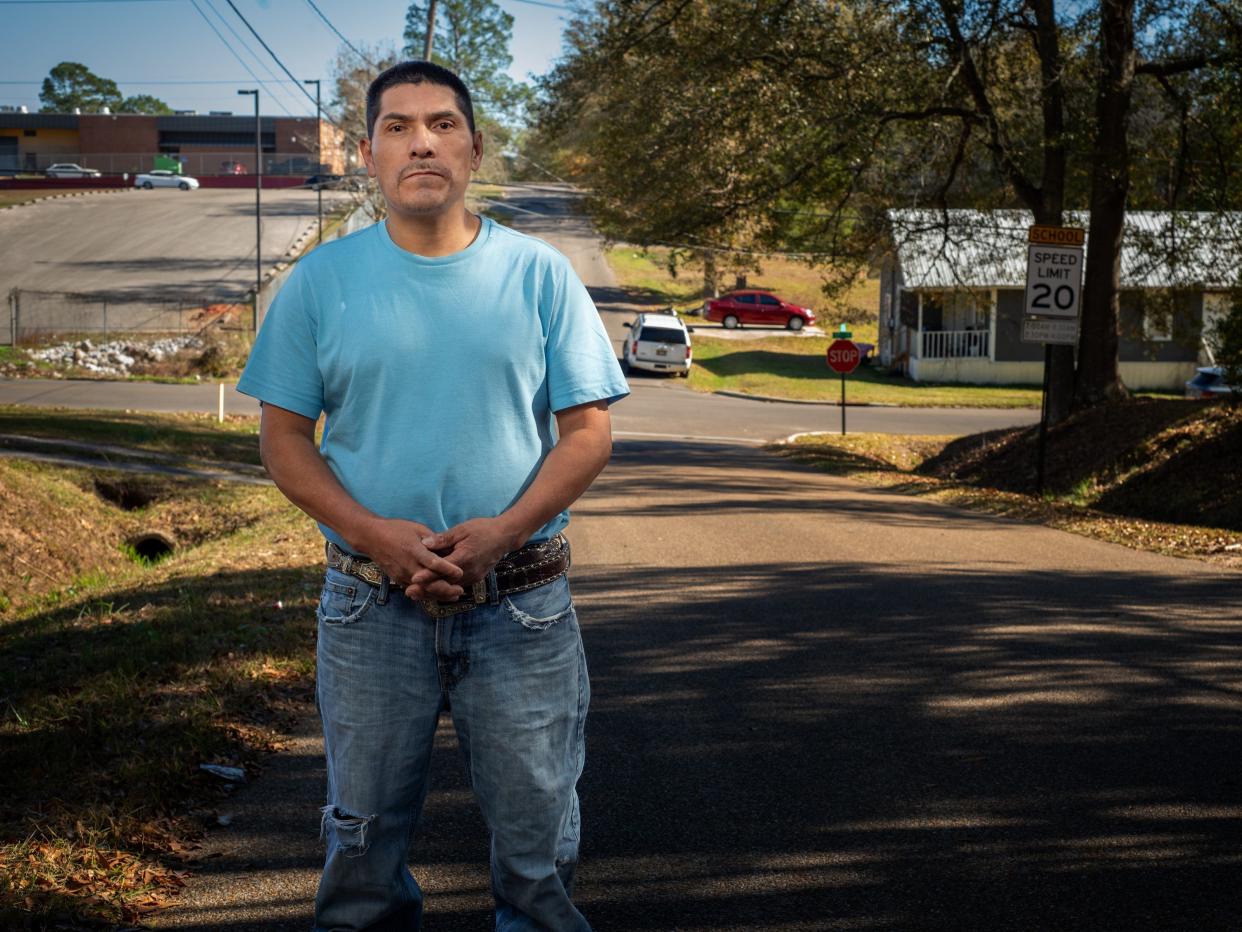
This article was reported in partnership with The Trace and Type Investigations.
Nemesia Martinez was working at one of Mississippi's dozens of poultry plants on July 20, 2016, when she missed a call from her neighbor. It was 9 p.m., and her shift defeathering and extracting the livers from chickens, at a facility about an hour outside Jackson, wouldn't end until 10:30. But Martinez had a feeling something was off. When she went to the bathroom to call back, her neighbor told her: "There's police at your home. I don't know what happened."
Martinez, now 47, shared the modest ranch-style house with her partner, Gabino Ramos Hernandez, 48, and a few housemates. She and Ramos had landed in Laurel more than a decade earlier, attracted by the plentiful if grueling poultry work, and had built a stable life for themselves. But they were both unauthorized immigrants, and the threat of arrest by immigration officials was a part of life.
Martinez arrived home at about 11 o'clock, filled with trepidation. There, she saw a patrol car and a white van along with three agents, one of whom was wearing a vest from Immigration and Customs Enforcement. Like every poultry worker in Laurel with her immigration status, Martinez had heard about the agency's raids and deportations and knew how to recognize and avoid its agents.
Anxious that Ramos had been arrested, and worried about risking arrest herself, she turned around and headed to a friend's place to spend the night. "I was afraid," she said. Ramos wasn't picking up his phone, and she struggled to get to sleep that night, not knowing what had happened.
Meanwhile, news of a shooting in Laurel began circulating on Facebook and WhatsApp. Friends began messaging Soledad Ramos Hernandez, Ramos's younger sister, to send condolences, assuming her brother had been killed. That's how Soledad first got wind that her brother might have been shot. She had no idea where he was, or whether he was even alive.
"How am I supposed to tell my parents if he died?" Soledad remembered thinking.
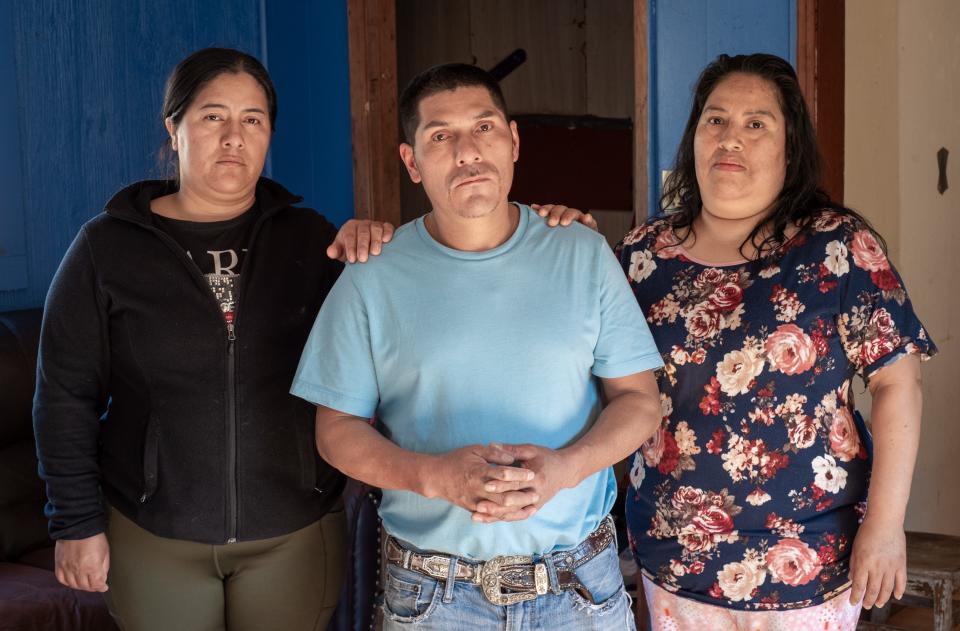
Approximately one in every 20 US workers is unauthorized, and Donald Trump has threatened to enact mass deportations of those workers and their families if he is again elected president.
Yet when and how ICE agents use deadly force has long been shrouded in secrecy. Last year, a federal oversight agency found that ICE had failed to thoroughly documents its use-of-force incidents.
Previously unreported bodycam footage and documents related to Ramos's encounter with ICE agents that day in July 2016 offer an unusual window into the use of deadly force by immigration agents, and what happens in the aftermath.
Public records obtained through litigation show that Ramos's shooting was not an isolated case. It was one of 59 shootings by ICE officers from 2015 to 2021 that took place across 26 states and two US territories, including two that were self-inflicted. At least 24 people were injured in the shootings.
Twenty-three were killed.
This first comprehensive look at ICE shootings across the country, a collaboration among Business Insider, The Trace, and Type Investigations, shows that several incidents went unexamined and others appear to have violated the agency's own policies.
The use-of-force logs we obtained are bare-bones and selectively redacted. They include the location and the date of the shooting and list injuries and deaths. But they don't include agent or victim names or narrative details. We've pieced together additional details from police departments, prosecutors, police and court records, an inspector-general report, and local media coverage. We could not identify supplemental records for 18 of these shootings that might have shed light on the circumstances surrounding them.
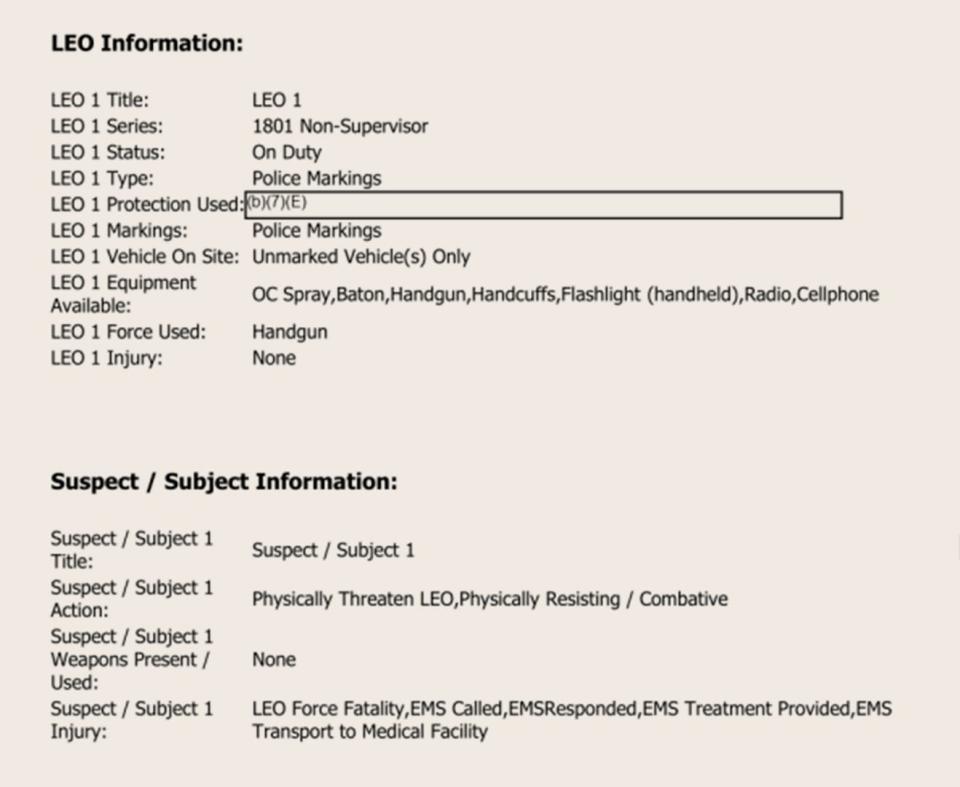
Many of the shootings posed considerable risks to bystanders. ICE agents shot people in public places, such as traffic intersections and strip-mall parking lots. They fired their weapons at moving vehicles. In at least a dozen cases, we uncovered evidence suggesting that the shooting victims were unarmed.
This full list of incidents has never been publicly reported by ICE. And if any of the officers who fired their weapons were disciplined, ICE has kept that secret, too.
ICE has even refused to release its current use-of-force policy.
ICE agents are assigned to either civil immigration enforcement — detaining and deporting unauthorized immigrants like Ramos — or criminal investigations. The latter are led by Homeland Security Investigations, a division of ICE that partners with other law-enforcement agencies to investigate cross-border crimes ranging from drugs and weapons smuggling to financial crimes. A large proportion of the shootings we uncovered involved HSI agents, and some occurred during genuinely risky operations such as undercover drug busts or multi-agency raids targeting human-trafficking operations.
Yet in over half of the shootings we identified, ICE agents never made an arrest. In at least seven cases, the person shot by an ICE officer was not the target of the enforcement action. Eleven shootings occurred while officers were off-duty.
With more than 12,000 agents, ICE is one of the largest federal law-enforcement bodies in the country, bigger than any local police department other than the New York City Police Department. Yet many other large law-enforcement agencies have more independent oversight than ICE. For instance, the Los Angeles Police Department, which employs about 9,000 officers, has an internal-affairs division, a professional standards bureau, an independent board of police commissioners, and an inspector general to investigate misconduct.
At ICE, oversight of misconduct is fragmented. It's handled sometimes by ICE, sometimes by ICE's parent agency, the Department of Homeland Security, and sometimes primarily by local law enforcement with jurisdiction in the location where an incident took place. The results of ICE's internal investigations are not made public.
Not a single shooting we examined resulted in an indictment anywhere in the country, even in instances when ICE's narrative of a shooting was contradicted by video footage. In some of these cases, ICE agents hindered investigations by violating protocols.
Chuck Wexler, the executive director of the nonprofit Police Executive Research Forum, says federal agencies haven't faced a "reckoning" about use of force the way municipal police departments have in recent years.
"Generally speaking, there's a big difference, a huge difference, between what federal law enforcement does and what municipal law enforcement does," he said.
ICE has admitted to wrongful use of firearms only once since 2016, after an ICE agent accidentally fired his weapon during an apartment search. No one was injured. The person of interest was not there, but ICE conducted an impromptu arrest of someone else on the scene.
Genia Blaser, an attorney with the New York nonprofit Immigrant Defense Project, described the cases we examined as being part of a long-standing pattern of unnecessary escalation.
"We have regularly seen that ICE tactics and arrests themselves created violence, and how quickly ICE agents escalate," she said, "from kicking down doors to holding people at gunpoint in front of children."
Miguel Alvarez, an ICE spokesperson, declined to respond on the record to detailed queries about our investigative findings, including whether any ICE agents have been disciplined over their use of deadly force. But he said ICE agents operate with "the utmost integrity" and that "leadership across the agency and department further reinforce standards of ethical and responsible conduct to further build and maintain public trust."
"ICE's mission brings an authority to use force when necessary," Alvarez said by email. "Authorized law enforcement officials are highly trained to only use force as a last resort when objectively reasonable and necessary, and to leverage de-escalation tactics. ICE personnel are regularly re-trained, and required to be familiar with all applicable directives, guidance, and policy and take appropriate action to comply with relevant laws and procedures. Any deviation or violation is investigated thoroughly, and if substantiated, disciplinary and/or other appropriate actions are taken."
DHS did not respond to queries.
Like the rest of his siblings in Puebla, Mexico, Ramos only finished the fourth grade. He knew from childhood that he would probably follow the path laid by his older cousins and move to Mississippi to work in a poultry plant.
The first time he tried to cross into the United States, at age 23, he was caught by Border Patrol. The final time he tried, in 2002, carrying only a change of clothes and a bottle of water, he crossed through the desert into Arizona and made his way to Phoenix, where his cousins picked him up and drove him to southeastern Mississippi. There, he found work at a poultry plant in Laurel, about an hour and a half outside Jackson.
He spent years jumping between the poultry plant and other day work, earning enough to send a few hundred dollars to his family back home each month.
The following account of what happened to Ramos that summer evening in 2016 is based on body-camera footage, ICE incident and investigation reports, a DHS inspector general report, a lawsuit filed against the ICE agent, court depositions, reports from the Laurel Police Department and the Mississippi Bureau of Investigation, and interviews with Ramos, his partner, and his sister.
That evening, Ramos stopped by a friend's home in Laurel for a birthday party. After having several beers, he and his then housemate each got in their cars for the drive home.
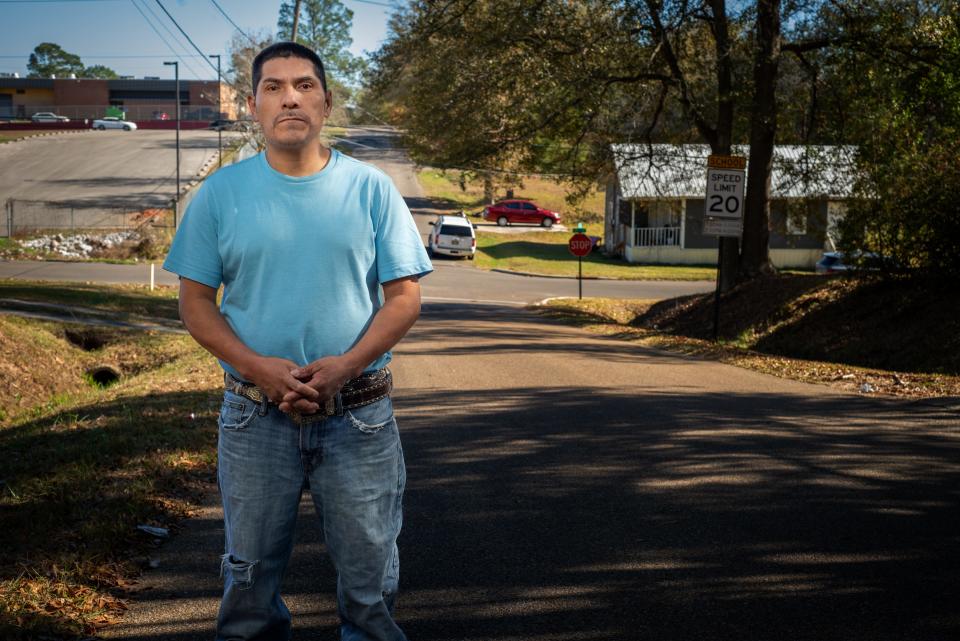
According to a subsequent deposition by a Laurel police officer, Jake Driskell, he and another officer saw Ramos and his housemate roll through a stop sign. They suspected that the housemate, who was driving behind Ramos in a white Nissan, was intoxicated and pulled him over in a grassy driveway behind the home he shared with Ramos. Ramos pulled over, too. The men stepped out of their cars, and Driskell asked the housemate a few questions: "Do you speak English?" "Do you have ID?"
Video shows that within minutes, Driskell walked back to his squad car and called nearby ICE agents to the scene. Laurel police officers described Ramos as "mouthy" and asked for Spanish translation assistance.
When the immigration officers arrived, Ramos recognized them as ICE and bolted, running around to the street in front of his home. An ICE agent, Phillip Causey, ran after him, yelling at him to stop. "Baja!" (Down!) Causey can be heard yelling. "Get down! Get on the fucking ground! Get the fuck down!"
Scared and confused, Ramos gave up and stopped running, according to a subsequent civil complaint. He turned around and walked back toward the agents. When Causey ordered Ramos to put his hands up, according to Ramos' complaint, he lifted one into the air, using the other to hold up his falling pants.
That's when Causey shot him.
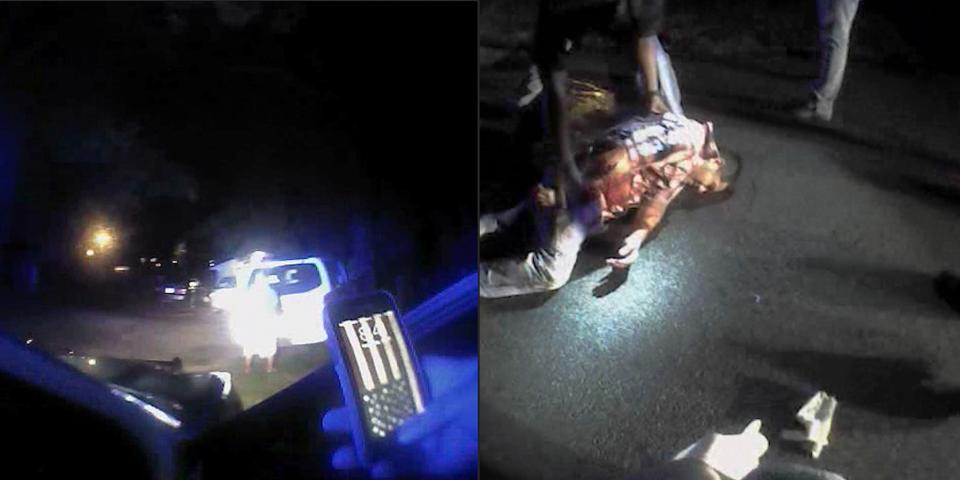
Ramos wasn't the target of the police stop. And neither he nor his housemate was the target of an immigration enforcement action. But Ramos still became one of dozens of people on the receiving end of an ICE agent's deadly force.
Causey's bullet penetrated Ramos's arm, hitting bone. Another officer's body camera appears to show him running toward Ramos. In an otherwise pitch-black street, the officer's flashlight shows Ramos writhing in pain, bleeding onto the black asphalt.
"You shouldn't have went for your pockets," Causey yelled at Ramos as he crouched over him, putting pressure on the wound. Soon, eight officers stood around Ramos, a mix of ICE agents and Laurel police officers, as his plaid shirt became saturated with blood. "Me no hear nothing," Ramos said, in between shrieks of pain.
The police tried to remove Ramos's shirt to access the wound and provide first aid as he twisted and thrashed. When they rolled him on his side looking for signs of other injuries, Ramos screamed.
He lay on the asphalt until an ambulance arrived and paramedics loaded him onto a gurney. "Please," he groaned.
ICE agents have shot other unarmed people.
In a February 2018 shooting in Dumfries, Virginia, an ICE agent, who was a member of a US Marshals fugitive task force, killed an unarmed man named Mario Bass by shooting him as he was fleeing arrest. The commonwealth's attorney's office began to investigate but abruptly stopped, saying it lacked jurisdiction, and wrote an opinion saying the ICE agent enjoyed immunity from state prosecution while acting as a federal agent.
The case was turned over to the FBI, the attorney's office told us, but the Justice Department did not respond to queries about whether it had investigated. Bass' family wrote a letter to the commonwealth's attorney saying that by failing to prosecute the ICE agent, "you have endangered the lives of every citizen in the county of Prince William and the larger community.
In September 2019 in Nashville, a deportation agent shot at a man twice as he drove a truck out of a grocery-store parking lot that has heavy foot traffic. An ICE spokesperson, Bryan Cox, told reporters the man behind the wheel drove toward the agents. Video footage obtained by a local TV station shows that the truck was parked when the ICE agents drove up and then shows the agent, later identified as Bradley Epley, drawing his gun and giving chase as the truck pulls away. Epley then fires a shot through one of the truck's windows. The FBI, which was tasked with investigating an attempted-assault allegation against the driver, declined to charge the driver.
Alvarez, the ICE spokesperson, declined to comment on this incident, or any other shooting incident, including whether the agent involved was disciplined. He also said ICE does not comment on investigations or litigation.
DHS's 2018 use-of-force policy says that shooting to disable a moving vehicle is prohibited. But the Nashville incident was one of 18 shootings we identified that appear to have involved a moving vehicle, including several car chases. These shootings were connected to at least nine deaths and six injuries.
The use-of-force policy says agents should try to place the public in as little danger as possible when discharging a weapon. Yet in many of the incidents we reviewed, agents may have put civilian safety at risk. Twenty-one shootings took place in public spaces, such as parking lots or traffic intersections.
In June 2017 in Denver, a deportation officer named Rueben Coray fired once at Hector Santana-Arreola, grazing his forehead, after he fled a traffic stop at a commercial intersection.
The Denver district attorney later said that Santana, who was wanted on two felony warrants, had a knife in his hand within arm's reach of the officers. Santana was charged with first-degree assault; the Denver DA's office decided not to indict the ICE officer who shot him.
A July 2018 shooting in Phoenix appeared to be among the most dangerous to passersby. Agents engaging in a narcotics operation opened fire in a commercial parking lot lined with shops and an urgent-care facility. The agents shot at the driver at least twice, injuring him. ICE offered inconsistent explanations for the shooting. An ICE spokesperson told local reporters that agents fired their weapons after a driver tried to "ram them with a vehicle." But an ICE log, which we obtained, says agents noted the suspect had a handgun. (The log made no mention of the vehicle being used as a weapon.) The man who was shot acknowledged having a handgun in the car but said in an interview with Phoenix police investigators that he didn't point it at anyone.
A store clerk who witnessed the shooting told local media they saw the police remove a young boy who'd been sitting in the car's passenger seat. The 4-year-old, the son of the man's girlfriend, was injured by shards of the windshield shot out by one of the agents.
Maricopa County prosecutors later said the agents did not provide statements until nine days after the shooting, in violation of protocol. As a result, prosecutors said, it would be difficult for the agents to be "fully cleared of any wrongdoing." They did not recommend criminal charges.
In another incident in a commercial parking lot, an undercover drug sting gone awry in Mesa, Arizona, in May 2018, agents shot a suspect 17 times. US Customs and Border Protection agents and Maricopa County sheriff's deputies who were also part of the mission didn't fire a single shot. The Maricopa County Attorney's Office, which investigated the incident, did not recommend any charges either.
A significant number of the shootings documented in the logs happened while ICE agents were off-duty or in plain clothes. At least two occurred during attempted robberies, but others were provoked by far less.
In Lithia Springs, Georgia, in February 2019, an off-duty ICE agent, Othello Jones, pulled into a Walmart parking lot with his wife and three kids. Surveillance video captures Jones stepping out of his car and pointing his gun at another car as it pulls into the spot next to his. His wife called 911, saying the man in the other car had followed them and had a gun. In a matter of moments, Jones shot the man in the chest, killing him.
The victim, later identified as 45-year-old Johnathan Liddell, did have a weapon in the vehicle — a pellet gun.
Douglas County prosecutors declined to press charges. "This was a justified shooting," said District Attorney Ryan Leonard at a press conference held less than two weeks later, arguing that Jones had faced a reasonable threat. "Nothing that he did is criminal."
For more than a decade, ICE agents operated under an interim use-of-force policy, which the DHS Inspector General's Office said was outdated and didn't incorporate lessons learned since its establishment.
Then, in May 2022, President Joe Biden signed an executive order mandating that DHS update its use-of-force policies to align with new standards at the Department of Justice.
DHS updated the use-of-force policy in February 2023 and instructed all of its agencies, including ICE, to do the same. ICE confirmed that it had created a new policy in 2023 but refused to release it to us, saying the policies had "not been published for public view" but that the policy meets or exceeds DHS policy in all material respects. ICE did later publish the policy document — with all but two sentences fully redacted.
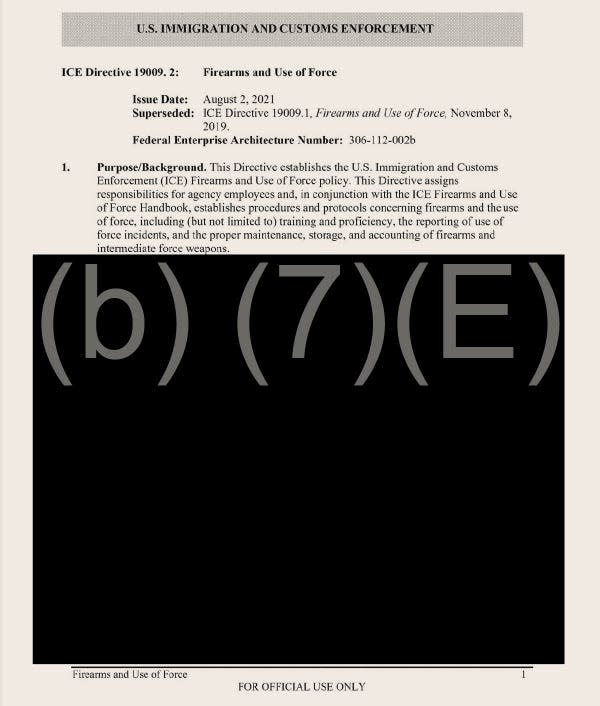
César Cuauhtémoc García Ramos, a professor of civil rights and liberties at Ohio State University Moritz College of Law, said it's "next to impossible" to access ICE's use-of-force policies because no law requires it. He also said the agency's policies are unlikely to evolve until they're made public. "If you don't know how they're operating because they're hiding it, it makes it really hard to get that democratic oversight," he said. "You don't know what your starting point is."
An internal ICE handbook from 2021 sheds some light on the procedures agents are supposed to follow in the field.
Both the February 2023 DHS policy governing use of force and the 2021 ICE handbook direct agents to de-escalate situations when possible and give verbal warnings before using a deadly weapon.
But the 2021 handbook has different reporting requirements from ICE's 2004 interim use-of-force policy. While the interim guidance instructed agents to "immediately" report an incident to their supervisor, the updated guidance says agents should report an incident within an hour only "if it is safe and possible to do so"; otherwise they can do so "as soon as is possible."
Both handbooks require the agent's supervisor to follow up with a written report to ICE's Office of Professional Responsibility; the 2021 handbook shortens that deadline from five days to 48 hours.
Across these ICE and DHS policies, any use of force must be both "reasonable" and "necessary," such as when required for agents to protect themselves or to prevent the escape of a suspect who poses a serious danger to others. A DHS 2018 policy provides even sharper guidance on the use of deadly force — that officers must have a reasonable belief that they face imminent danger of serious bodily injury or death.
The 2023 DHS policy says deadly force cannot be used against a person "whose actions are only a threat to themselves or property." With limited exceptions, it also forbids agents from shooting a firearm from a moving vehicle or to disable a moving vehicle.
DHS policy now requires that officers be trained in the use of deadly force at least annually and requires DHS agencies, including ICE, to ensure their officers are proficient in de-escalation tactics and techniques.
ICE's 2021 handbook also prioritizes de-escalation. "When feasible," it reads, "Authorized Officers shall employ tactics to de-escalate, i.e., stabilize, slow, or reduce the intensity of, a potentially violent situation without using physical force."
The evening after the shooting, Martinez again got a call during her shift. This time, it was Soledad, Ramos's sister.
Soledad had spent much of the night calling hospitals, trying to find her brother. She finally found the local hospital where he'd been admitted and discovered he'd been transferred to another a half an hour away, where he was scheduled for surgery the next morning.
The following day, Soledad went to bring Ramos home. She brought her 9-year-old son to the hospital with her, hoping that if ICE agents were there, they wouldn't arrest her with her young son. When she saw her brother, attached to tubes and wires, his arm bandaged, Soledad burst into tears.
Doctors found that the gunshot had "completely lacerated" his radial nerve, medical records show, requiring the administration of IV antibiotics. The surgeries would ultimately be extensive, involving a bone graft, the installation of a plate, and the removal of muscle tissue.
"I remember when we left, he was in a robe because we didn't know where his clothes were," Soledad said. The bloody garments had likely been discarded.
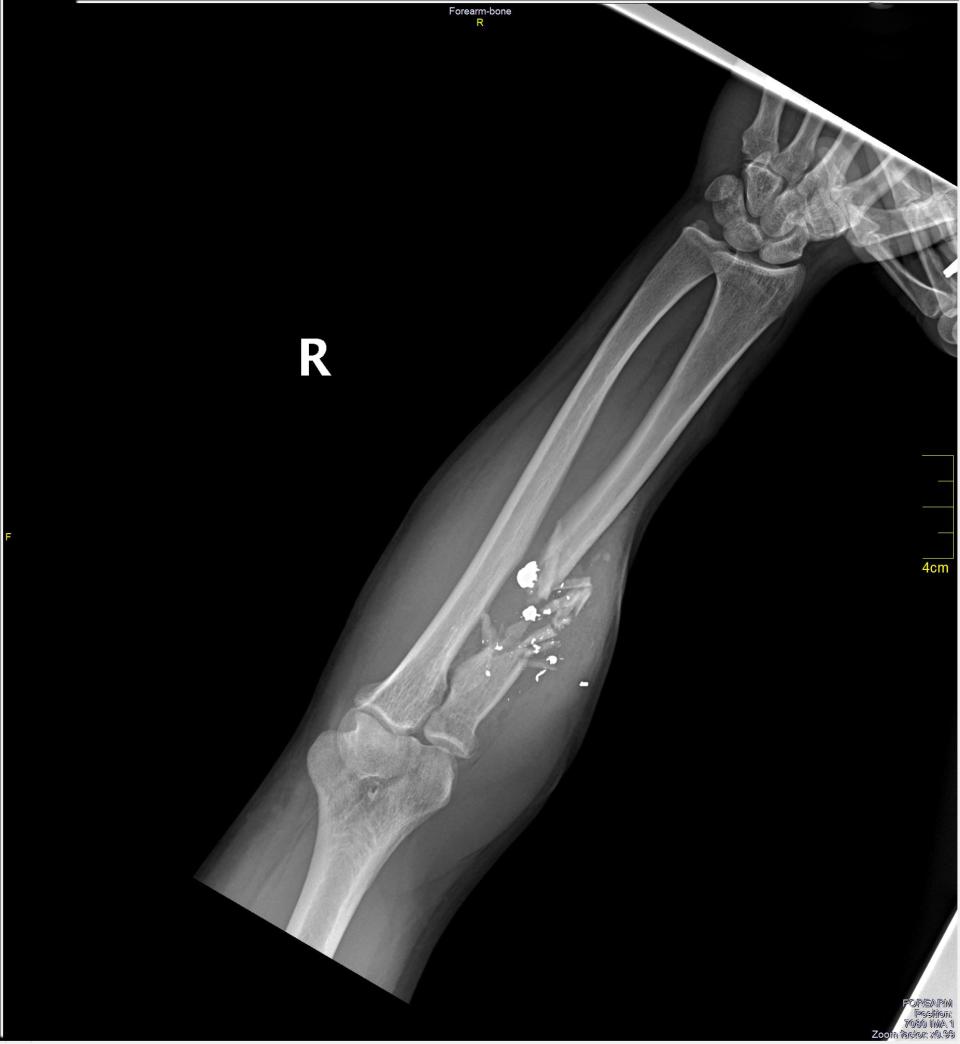
The women were not Ramos's first visitors.
At about 3 a.m., just six hours after the shooting, a Mississippi Bureau of Investigation officer named Leo Clemons arrived at the first hospital to interview Ramos.
Doctors had given him painkillers, but Ramos was still in immense pain. Clemons described his condition in an incident report as "groggy" but said he "was able to speak enough broken English for us to have a conversation." Ramos later told us that was not the case; he said he was so disoriented during the questioning by Clemons that he did not even remember meeting him. "I was practically unconscious," he said.
In a 26-minute audio recording of the interview, Ramos moans frequently. He does not seem to understand all the questions. Clemons asks him to explain what happened and whether he could see the officer who shot him. "You heard him but you couldn't see him?" Clemons asks. "I don't know. I don't understand anybody," Ramos responds.
Clemons did not request Spanish translation assistance, though it appears he knew he needed it; at one point he asks a nurse who comes to check on Ramos's vitals if she speaks Spanish.
Though Ramos was interviewed within hours of being shot, the two Laurel police officers and one ICE officer at the scene waited a week to come into the station for questioning. Causey, the officer who shot Ramos, wasn't interviewed by MBI until two weeks later. MBI promised Ramos that an officer would interview him again after he got out of the hospital, but Ramos said no one ever did.
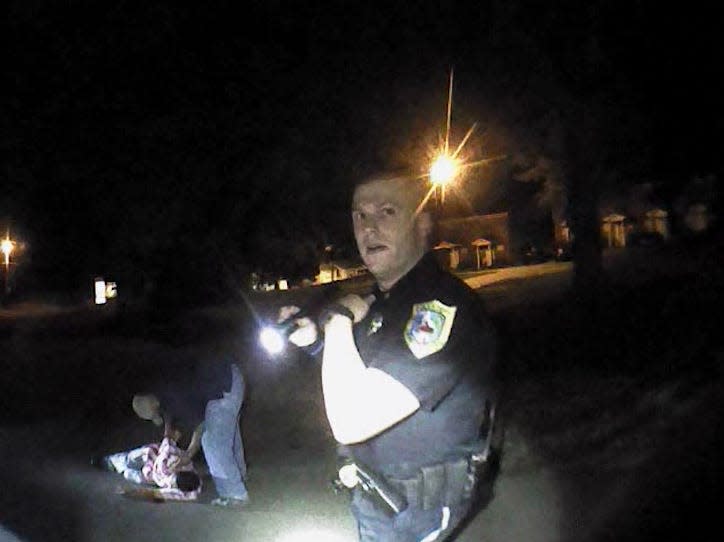
An MBI spokesperson, Bailey C. Martin, said Clemons was no longer with the bureau and he could not comment on "decisions made pertaining to a particular investigation." Alvarez, the ICE spokesperson, declined to respond to detailed queries about the incident.
It may seem unusual that MBI was the agency that handled the Ramos shooting. But documents we obtained show that ICE assigned jurisdiction to another law-enforcement agency in nearly half of the shootings by its agents that took place from 2015 to 2021.
Alvarez, the ICE spokesperson, confirmed that ICE is required to notify local law enforcement of any allegations involving potentially criminal behavior, and that ICE and the DHS inspector general cooperate on any local law enforcement investigations. Yet we found that confusion over who had jurisdiction might have allowed some cases to escape criminal investigation.
In October 2019, for example, a deportation officer fired his weapon in Metairie, Louisiana. ICE said that while no one was struck or injured, the Jefferson Parish Sheriff's Office would investigate. But the sheriff's office told the local NBC affiliate that it never opened an investigation. The Jefferson Parish Sheriff's Office did not respond to requests for comment.
It's not clear the fatal shooting of Mario Bass in Virginia was investigated either, once the Prince William County Commonwealth's Attorney's Office found it didn't have the authority to investigate. The office said it turned over all of its investigative files to the FBI, but the FBI press office said the bureau could neither confirm nor deny the existence of an investigation and declined to comment further.
We identified several cases in which ICE agents may have hindered investigations by failing to follow protocol or provide documentation.
In one case in Scottsdale, Arizona, in March 2018, a special agent with ICE's Homeland Security Investigations division, working in a team of three, fired at least three shots at a suspect who fell back onto the ground with a gun still in his hand. While writhing from his injuries, he pointed the weapon in the general direction of the special agent, according to a Scottsdale police report shared with us by Howard Center for Investigative Journalism at Arizona State University. The agent shot the man again, according to witnesses interviewed for the report, killing him.
The Maricopa County District Attorney's Office investigated the incident and concluded that the HSI agent had disregarded the county's officer-involved shooting protocols by failing to remain on the scene and refusing to participate in interviews until six days later. The agent who repeatedly fired his weapon violated policy in four different ways, the investigators found, but was "excused by on scene Federal Homeland Policy Security Supervisors who relied on Internal Policies to justify the decisions made at the scene," the DA's report said. The DA's office said the violations could "justify further investigatory steps" but cleared the agent of wrongdoing anyway.
Similarly, in the Mesa, Arizona, incident in May 2018, when three agents fired 17 shots, killing a suspect, the Maricopa County DA found that the agents violated protocol by failing to remain on the scene and delaying their interviews — in this case for eight days.
In a June 2016 incident in Chula Vista, California, an HSI agent named Chris Baroni advised a fellow HSI agent, Ronaldo Gonzalez, not to participate in an investigation. Gonzalez had just shot and killed someone, according to a transcript of the body-wire recording obtained by the victim's family. "Don't worry about it," Baroni told him. "Remember ... no statements, none of that shit." (Attorneys representing Baroni and Gonzalez declined to comment on their behalf.)
Jerry Robinette, who once oversaw Homeland Security Investigations operations as a special agent in charge, says the internal process for investigating ICE shootings is a "quagmire" littered with potential dead ends.
First, the agent must file a report for agency review.
If there's an allegation of misconduct, DHS's Office of Inspector General has the right of first refusal to investigate. If the incident involves a shooting, whether or not the inspector general gets involved, the case goes to ICE's Firearms and Use of Force Incident Review Committee. That committee determines whether the use of force violated ICE or DHS policies and whether the agency needs to respond by making changes to policy, tactics, or training.
If an incident involves potentially criminal behavior, and it's not taken up by the inspector general, it will still get reviewed by ICE's Office of Professional Responsibility.
If either the inspector general or the review committee determines that a use of deadly force violated policy, the case is referred to OPR for further investigation, according to Gretta Goodwin, a director on the Government Accountability Office's Homeland Security and Justice team who has reviewed ICE's internal-investigation process. An officer's supervisor may also refer a case to the OPR.
"There is no consistency with how some of those shootings have been handled," said Robinette, who began his career as a US Customs special agent and ultimately managed a terrorist-financing task force in Washington, DC, before retiring in 2012.
He said the process could fall apart at any point — a supervisor may choose not to escalate an incident for review, and the review committee may choose not to recommend discipline. Getting to the point of actual discipline, if it's imposed at all, can take years, he said.
Because of inadequate recordkeeping, the GAO found, some use-of-force incidents might not be visible to DHS officials. And critically, the Office of Professional Responsibility doesn't have the authority to issue disciplinary measures. OPR simply issues recommendations and "local management is responsible for taking any appropriate disciplinary actions," the GAO report says such as a warning or a suspension. In other words, Goodwin says, an agent's frontline supervisors ultimately decide whether the agent will face professional consequences.
Goodwin calls this a critical shortcoming.
"The board is saying, 'This is a violation,'" she said of ICE's use-of-force review committee. "If they send it forward for disciplinary actions, and the manager decides not to discipline, it goes nowhere. That's it. So the individual who commits an egregious act doesn't get punished."
What those disciplinary recommendations are and whether they're implemented is never made public, even to oversight agencies. "There's no way for us to get at the heart of what happens after the board finds you're out of compliance," Goodwin said.
In many ways, the Ramos case illustrates how ICE has never developed a robust system of accountability.
After Causey shot Ramos, it took almost a year for the case to be brought before a grand jury. MBI led the criminal investigation, which DHS "monitored," according to a report by DHS's Office of the Inspector General.
The ICE interim use-of-force policy that was in effect at the time outlines a range of documentation the agency is required to collect when an agent uses deadly force, including witness and officer statements, medical reports, and photos and diagrams of the scene. But the inspector general's report made reference only to police statements and body-camera footage, indicating that the other documents may not have been collected or turned over.
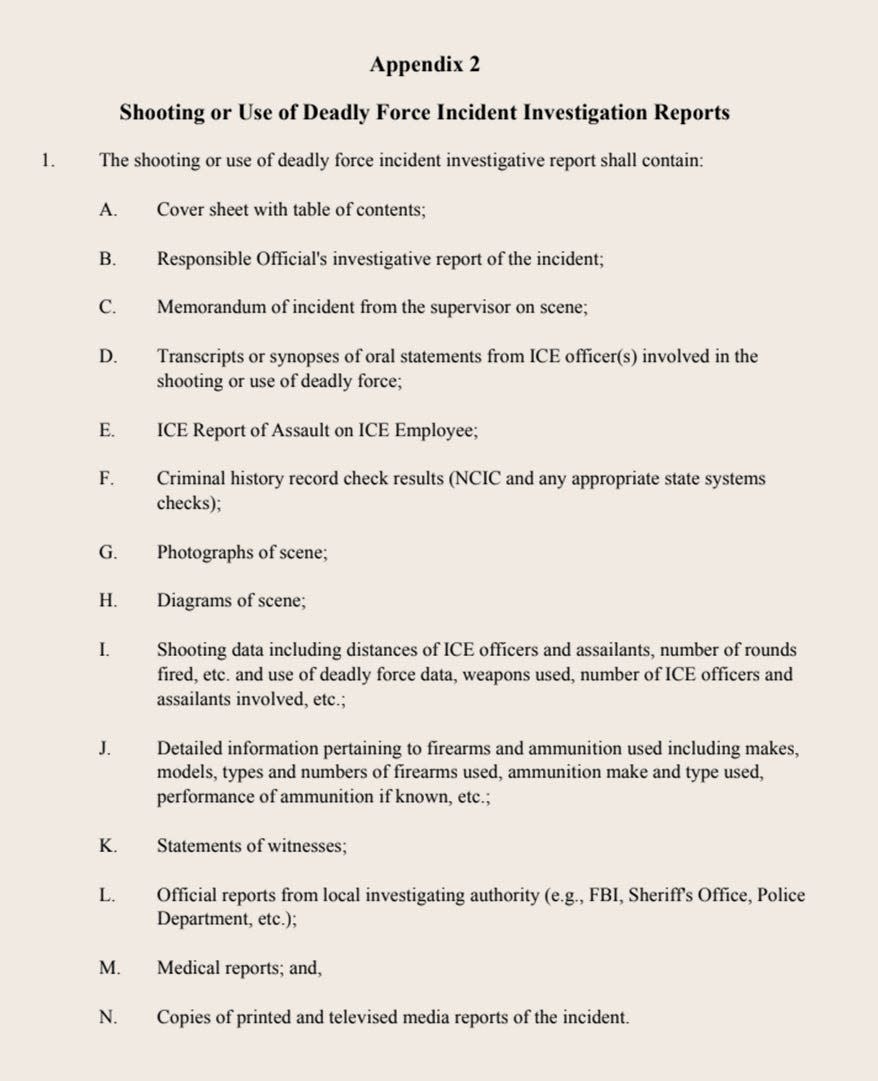
Tommy Cox, Laurel's police chief, told us that he was unable to recall whether ICE or MBI ever reached out to interview the officers present the night of the shooting.
The inspector general found that ICE didn't follow its own protocols in another way. The policy said any agent who uses deadly force that results in death or serious injury shall be placed on leave for three consecutive workdays. In Causey's case, he took time on his own accord and returned to work before the grand jury made a decision in the case, nearly a year after the shooting, not to indict him. He was never suspended, and the OIG report says there is no record of either his absence or his return.
A person whose name was redacted, presumably Causey's supervisor, told the inspector general's office that since the language in the policy says "shall," he didn't believe a leave of absence was "mandatory.
The Office of the Inspector General said it was unable to interview Causey, an Army reservist, because he was on active duty in Africa. The investigation closed, and the inspector general's report makes no mention of discipline.
Both ICE and DHS have repeatedly come under scrutiny for inadequate procedures to address employee misconduct.
In 2017, as ICE was enforcing Donald Trump's anti-immigration policies, the DHS inspector general found that the department lacked "policies that emphasize the respect for human life when using force."
In 2019, the OIG found that DHS was not adequately handling misconduct allegations because its policy "does not include procedures for reporting allegations of misconduct, clear and specific supervisor roles and expectations, or clearly defined key discipline terms."
"Without department-wide procedures," the report said, "DHS cannot ensure supervisors administer disciplinary actions consistently and may leave itself vulnerable to costly litigation."
DHS concurred with the report's recommendations, and subsequent reports by think tanks and human-rights organizations have come to similar conclusions. Yet DHS's new use-of-force policy, released in February 2023, does little to strengthen these shortcomings in oversight beyond establishing new data collection and reporting mechanisms, such as requiring that DHS agencies participate in the FBI's Use of Force Data Collection Program. It bars some dangerous practices — critically, it prohibits shooting at a moving vehicle — but it does not provide remedies for people harmed by such practices in the past.
A 2020 report from the Center for a New American Security found "fragmented oversight" at DHS; a year earlier, the DHS inspector general told Congress that the agency was "struggling to mature as an organization" and suffered a "dysfunctional work environment."
"No administration has been committed to reining in their power," said Jennifer Chacón, a professor of immigration, constitutional, and criminal law at Stanford Law School. "When it comes to accountability for agents, you don't see a lot there."
García Ramos, the professor at Ohio State Law, says ICE's aggressive policies enacted under Trump remain today. "Even if they weren't created under Biden, the Biden administration has taken ownership of them," he said. "I would want DHS leaders and the White House to take seriously that the largest armed law-enforcement agency in the country are constantly interacting with ordinary people and those people have a lot at stake and should be able to understand what to expect of those armed law-enforcement officers."
Last July, the GAO found that DHS had undercounted use-of-force incidents across agencies and had never set up a plan to analyze use-of-force data. Even when DHS agencies did submit data, the report found, they sometimes recorded multiple uses of force as a single incident or in a single report, which not only disguised the true tally but lost track of incidents that could have informed policy or training changes.
The GAO report, which Goodwin authored, said it had previously recommended that two federal agencies, the Secret Service and ICE, issue updated data-collection policies. The Secret Service complied in February 2023, but ICE still has not.
As the GAO was preparing its report, ICE reported that it had implemented a couple of changes to its policies and training curriculum. But Goodwin said ICE didn't provide any substantiation that those changes had been made.
In complying with Biden's May 2022 executive order, DHS, for the first time, required its member agencies to report use-of-force data — but asked for data going back only to 2018.
A year after he was shot, Ramos hired an attorney, Timothy Cerniglia, who has since brought a lawsuit against Causey. In preparing for the suit, Cerniglia was stymied by ICE's opacity. In response to a Freedom of Information Act request, the agency refused to give him the use-of-force incident report, citing a state exemption for law-enforcement investigations.
By February, a judge had dismissed all the claims, saying he had failed to prove that the agents had violated his constitutional rights. In April, Cerniglia filed an appeal.
"Private lawsuits are basically the only option and they're not a particularly great option," said García Ramos, the Ohio State Law professor. "But really they're the only genuine mechanism for someone who is aggrieved because of an ICE agent's use of force to be heard."
Martinez, Ramos's partner, said her life has two eras: before and after the shooting.
Once Ramos came home from the hospital, she was the one who helped him shower, fed him, and organized his medication. She also took over financial responsibilities for the household.
Ramos's recovery has been slow. He spent nearly two years in the bedroom the couple shared, where the window looks out onto the street where he was shot. Martinez says he still sometimes experiences a dread so severe he does not leave his bedroom all day.
"It just left him feeling really depressed and with no sort of energy," Soledad said. "He was suffering every day."

Eight years later, he still hasn't been able to pay off the $5,000 he owes for the surgeries he received to treat the gunshot wound and later to graft and replace damaged bone. He hasn't regained full mobility in his arm. And he never returned to the poultry plant.
Because she needed to be home more and couldn't work late hours, Martinez had to quit her job at the poultry plant, too. To maintain a flexible schedule, she turned to cleaning homes and selling street food. The pay was less, and more sporadic, and yet her earnings had to support them both. Soon, Martinez also stopped sending money back home to her family in Oaxaca — her two daughters and her 93-year-old mother.
For years after the shooting, Ramos's main form of income was working the blueberry harvest. But the picking season is very short — less than three months of the year.
"I came to work, and now I can't do that," he said.
Driskell, the Laurel police officer who pulled them over that night, never indicated to Ramos that he was getting a traffic ticket, according to court documents. But Driskell wrote up two while Ramos was in the hospital.

Ramos and Martinez had been thinking about going back to Mexico anyway. What's the benefit of being here any longer? they asked each other. He's been worried his aging mother might die soon.
But Soledad insisted that Ramos stay through to the end of his appeal. He may have been an unauthorized immigrant, she said, but he did not deserve to be shot in the act of surrendering.
"There's the sense that they have the right to use guns and that they will be protected," Soledad said. "He had no gun. He had nothing on him."
In early May, Ramos had another encounter with the Laurel police in which ICE got involved. He was pulled over for a suspected DUI, and this time the police said they found drugs in the car. Ramos denies that the drugs were his, but he hasn't yet had a chance to enter a not-guilty plea.
On May 30, he was brought from the Laurel jail into ICE detention, where he remains.
A grant from the Fund for Investigative Journalism supported research for this story. Loevy & Loevy provided pro bono legal support in a public-records suit.
Credits:
Reporting: Lila Hassan
Editing: Aviva Shen, Tali Woodward, Esther Kaplan, John Cook
Research: Paco Alvarez, Emma Davis, Rosemarie Ho, Schuyler Mitchell, Iqra Salah, Nina Zweig
Photography: Tim Ivy
Data visualization: Daniel Nass
Design and visuals: Rebecca Zisser, Selin Thomas, Isabel Fernandez-Pujol
Read the original article on Business Insider

